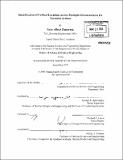Identification of critical locations across multiple infrastructures for terrorist actions
Author(s)
Patterson, Sean A. (Sean Albert), 1981-
DownloadFull printable version (3.921Mb)
Other Contributors
Massachusetts Institute of Technology. Dept. of Nuclear Engineering.
Advisor
George E. Apostolakis.
Terms of use
Metadata
Show full item recordAbstract
This paper discusses a possible approach to ranking geographic regions that can influence multiple infrastructures. Once ranked, decision makers can determine whether these regions are critical locations based on their susceptibility to terrorist acts. We identify these locations by calculating a value for a geographic region which represents the combined values to the decision makers of all the infrastructures crossing through that region. These values, as well as the size of the geographic regions, are conditional on a minor destructive threat of a given size, e.g,. a bomb that can affect objects within 15 feet of it. This approach first requires an assessment of the users of the system. During this assessment, each user is assigned a performance index (PI) based on the disutility of the loss of each infrastructure's resource via multi-attribute utility theory (MAUT). A Monte Carlo network analysis is then performed to develop importance measures (IM) for the elements of each infrastructure for their ability to service each user. We combine the IMs with the user PIs to a value that we call valued worth (VW) for each infrastructure's elements independently. (cont.) Then we use spatial analysis techniques within a Geographic Information System (GIS) to combine the VWs of each infrastructure's elements in a geographic area, conditional on the threat, into a total value we call geographic valued worth (GVW). The GVW is graphically displayed in the GIS system in a color scheme that shows the numerical ranking of these geographic areas. The map and rankings are then submitted to the decision makers to better allocate anti-terrorism resources. A case study of this methodology is preformed on the Massachusetts Institute of Technology's (MIT) campus. The results of the study show how the methodology can bring attention to areas that may be ignored through individual infrastructure analysis. The intersections of major infrastructures on the campus prove to be of the most importance to the stakeholders of the campus.
Description
Thesis (S.M.)--Massachusetts Institute of Technology, Dept. of Nuclear Engineering, 2005. Includes bibliographical references (leaves 59-60).
Date issued
2005Department
Massachusetts Institute of Technology. Department of Nuclear Engineering; Massachusetts Institute of Technology. Department of Nuclear Science and EngineeringPublisher
Massachusetts Institute of Technology
Keywords
Nuclear Engineering.